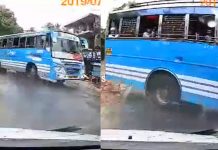A train is a form of transport consisting of a series of connected vehicles that generally runs along a rail track to transport cargo or passengers. The word “train” comes from the Old French trahiner, derived from the Latin trahere meaning “to pull” or “to draw”.
Motive power for a train is provided by a separate locomotive or individual motors in a self-propelled multiple unit. Although historically steam propulsion dominated, the most common types of locomotive are diesel and electric, the latter supplied by overhead wires or additional rails. Trains can also be hauled by horses, pulled by engine or water-driven cable or wire winch, run downhill using gravity, or powered by pneumatics, gas turbines or batteries.
Watch how trains are broken down for scrap when they are retired
Train tracks usually consist of two running rails, sometimes supplemented by additional rails such as electric conducting rails and rack rails. Monorails and maglev guideways are also used occasionally.
A passenger train includes passenger-carrying vehicles and can often be very long and fast. One notable and growing long-distance train category is high-speed rail. In order to achieve much faster operation at speeds of over 500 km/h (310 mph), innovative maglev technology has been the subject of research for many years. The term “light rail” is sometimes used to refer to a modern tram system, but it may also mean an intermediate form between a tram and a train, similar to a heavy rail rapid transit system. In most countries, the distinction between a tramway and a railway is precise and defined in law.
A freight train (or goods train) uses freight cars (or wagons/trucks) to transport goods or materials (cargo). It is possible to carry passengers and freight in the same train using a mixed consist.
Rail cars and machinery that are used for the maintenance and repair of tracks, are termed “maintenance of way” equipment; these may be assembled into maintenance of way trains. Similarly, dedicated trains may be used to provide support services to stations along a train line, such as garbage or revenue collection.



















